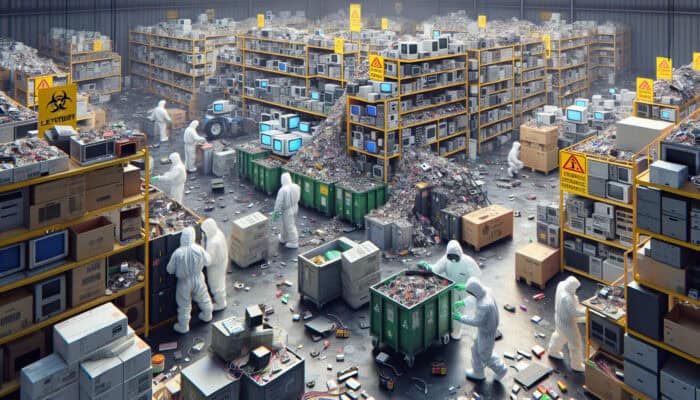Unlocking the Secrets of Electronics Clearance: A Guide to Environmental Stewardship
Adopting Electronics Clearance: Your Path to Sustainable E-Waste Management

In the UK, comprehending the cost of clearing electronics is vital to ensuring responsible recycling and disposal of electronic devices. This knowledge is crucial for averting serious environmental damage. With the ever-growing amount of electronic waste, it is essential that consumers and businesses alike recognise the significance of effective electronics clearance. Employing proper disposal techniques is critical to stop hazardous substances like lead and mercury from infiltrating the soil and contaminating water supplies, thereby safeguarding public health and safety. Furthermore, efficient clearance practices allow for the retrieval of valuable materials that can be reused in the production of new goods, promoting a sustainable cycle of resource utilisation that is beneficial for the environment.
The rapid increase in consumer electronics consumption throughout the UK has led to a significant build-up of electronic waste. As devices reach the end of their operational life or fail, many individuals are left uncertain about how to dispose of them in a responsible manner. Therefore, grasping the principles of electronics clearance transcends mere compliance with regulations; it represents a commitment to making ethical decisions that encourage environmental sustainability and contribute to a healthier planet for all.
The Critical Role of Responsible Electronics Clearance in Environmental Conservation
The importance of engaging in responsible electronics clearance cannot be emphasised enough. With the widespread use of electronic devices, the increasing rate of e-waste is becoming a pressing issue. If not handled properly, irresponsible disposal methods can result in significant ecological damage, including the pollution of vital soil and water resources. Thus, it is imperative to utilise responsible clearance methods to mitigate the environmental footprint associated with electronic waste.
Moreover, adhering to best practices in electronics disposal aligns with broader societal objectives, such as achieving the UK’s environmental goals and promoting sustainability efforts. By prioritising responsible electronics clearance, individuals and organisations can make a meaningful contribution, fostering a culture centred around recycling and the reuse of materials. Additionally, neglecting compliance with clearance regulations could lead to hefty fines and legal ramifications, highlighting the necessity of awareness and active participation in responsible disposal initiatives.
Grasping the Key Legislation Governing Electronics Clearance in the UK
The UK has implemented a robust framework of regulations that oversee the recycling and disposal of electronics. Central to this framework is the Waste Electrical and Electronic Equipment (WEEE) Directive, which mandates that manufacturers take responsibility for managing their products at the end of their lifecycle. This directive ensures that consumers receive essential information regarding the responsible disposal of their electronics.
Alongside the WEEE Directive, local authorities in the UK must adhere to specific protocols for the collection and processing of e-waste, guaranteeing that local services can manage these items safely and effectively. Non-compliance with these regulations can result in serious legal consequences for individuals and businesses alike. Familiarising oneself with these guidelines not only promotes responsible disposal but also elevates public consciousness regarding environmental stewardship, a concept that is becoming increasingly significant among citizens in the UK.
Investigating the Financial Dimensions of Electronics Clearance

Understanding Disposal Fees Associated with Electronic Devices
The financial repercussions linked to the disposal of electronics can differ markedly based on the type and size of the device in question. For smaller appliances, such as toasters or kettles, disposal charges are generally modest, often ranging from £5 to £15. Conversely, larger items such as televisions and refrigerators may incur significantly higher fees, typically between £20 and £50. This variation in disposal costs may dissuade many individuals from discarding their outdated electronics, thereby exacerbating waste accumulation.
It is crucial to note that certain local councils in the UK might integrate disposal fees into council tax or designate specific collection days for e-waste, thereby making the disposal process more accessible for residents. For businesses, the financial implications of electronics disposal can accumulate rapidly, especially when dealing with larger quantities of devices. Understanding these costs is essential for effective financial planning, as unexpected fees may arise, particularly when hazardous materials are involved.
Evaluating Recycling Costs for Electronic Devices
The recycling process for electronic devices often incurs its own set of costs, though some services provide free recycling options for certain items. Numerous retailers in the UK have adopted take-back schemes, allowing consumers to return old electronics at no extra charge when purchasing a new device. This initiative not only assists consumers in decluttering their homes but also encourages responsible recycling practices that are beneficial for the environment.
However, not every item qualifies for complimentary recycling, and consumers may face fees for recycling specific devices. These charges can range from approximately £10 for smaller electronics to around £30 for larger items such as laptops or printers. Being informed about these potential costs enables households and businesses to assess their options more effectively, ensuring decisions are made with both financial constraints and environmental impact in mind.
Spotting Additional Expenses Related to Electronics Clearance

When undertaking electronics clearance, additional costs may arise, particularly concerning the specialised handling of hazardous materials or the disposal of large quantities of items. For example, the disposal of items containing lithium batteries or CRT monitors typically incurs extra costs due to the specialised processes required for their secure disposal. Fees for such items can range from £10 to £100, depending on the service provider and the complexity of the disposal methods employed.
For businesses, these additional costs can become particularly pronounced, especially when clearing out outdated stock or office equipment. Proper planning and an understanding of potential extra expenses can significantly influence overall clearance costs. It is advisable for businesses to consult professional clearance services to obtain a comprehensive estimate of any possible fees before initiating the clearance process.
The Critical Importance of Data Destruction Fees in Electronics Clearance
A fundamental aspect of electronics clearance is guaranteeing that sensitive data is securely erased from devices prior to their disposal. Fees linked to data destruction can vary widely, typically ranging from £10 to £50 per device, depending on the method used. For example, a straightforward factory reset may incur lower charges, while more secure methods, such as the physical destruction of hard drives, tend to be priced at the higher end of the spectrum.
For businesses, investing in secure data destruction is not merely a financial consideration; it is an essential measure in safeguarding sensitive information. Various professional clearance services offer certified data destruction to ensure that vital data breaches are prevented. Understanding these fees is particularly crucial for businesses managing confidential information, as the long-term costs associated with a data breach can far exceed the expenses related to proper data destruction.
Implementing Effective Strategies for Streamlined Electronics Clearance
Utilising Local Council Services for Responsible Electronics Disposal
A multitude of local councils across the UK have established comprehensive electronics clearance services designed to help residents responsibly dispose of their electronic waste. Often funded through council tax, these services may include scheduled e-waste collection days or designated recycling centres where residents can conveniently drop off outdated devices. Such initiatives not only streamline the disposal process but also significantly reduce the environmental impact of electronic waste.
Local councils typically offer extensive guidelines regarding the types of electronics they accept and whether any associated fees apply. Councils may also collaborate with private recycling firms to ensure the effective processing of electronic waste. By engaging with local services, individuals contribute to a sense of community responsibility while supporting the UK‘s overarching recycling objectives, making it a convenient and eco-friendly choice for responsible electronics disposal.
Collaborating with Private Recycling Companies for Holistic Solutions
While local council services provide invaluable assistance, many individuals and businesses may prefer to work with private recycling companies for their electronics clearance needs. These firms usually offer a complete range of services, including collection, recycling, and data destruction. Although generally more expensive than council services, private recycling companies may deliver enhanced convenience and specialised expertise, especially for businesses managing large volumes of electronic waste.
Private firms often emphasise their commitment to environmentally responsible practices, ensuring that all materials are recycled sustainably. This transparency is particularly appealing to businesses aiming to enhance their sustainability credentials. Furthermore, many of these companies can customise their services to meet specific needs, offering bulk clearance options or managed services that streamline the disposal process while ensuring compliance with relevant regulations.
Exploring DIY Clearance Alternatives for Economical Disposal
For those looking to minimise expenses related to electronics clearance, DIY options can serve as a practical alternative. Numerous designated recycling centres throughout the UK accept old electronics for free or at a very low cost. By investigating local options, individuals can uncover various opportunities for responsible disposal without incurring significant financial burdens.
When considering DIY options, it is essential to ensure that the recycling centres are certified and comply with environmental regulations. Additionally, individuals should evaluate the types of electronics they wish to dispose of, as certain items may necessitate special handling. Although DIY clearance may require more effort, it empowers individuals to actively contribute to environmental sustainability while also achieving cost savings.
Evaluating the Environmental Consequences of Electronics Clearance
Strategies to Reduce Electronic Waste Through Responsible Practices
The rising tide of electronic waste poses a significant environmental challenge, particularly in the UK’s urban environments. Effective electronics clearance is crucial in alleviating this waste by ensuring that devices are recycled or disposed of safely and responsibly. By engaging in conscientious disposal practices, both individuals and businesses can collectively diminish the volume of e-waste that ultimately ends up in landfills, where it can persist for years, leaching harmful substances into the environment.
Recycling electronics not only aids in mitigating waste but also conserves precious natural resources. Valuable materials such as gold, silver, and rare earth metals can be extracted from outdated devices, helping to lessen the demand for new raw materials. This process is essential for fostering a circular economy, where resources are reused and recycled, yielding significant environmental benefits and promoting sustainability initiatives.
Safeguarding Natural Ecosystems from Electronic Waste Hazards
In the UK, improper disposal of electronics can lead to dire repercussions for natural ecosystems. Toxic substances present in electronic devices, such as lead and cadmium, can seep into the soil and waterways, resulting in the contamination of vital ecosystems. This poses a substantial risk to both wildlife and plant life, disrupting the delicate balance of natural habitats.
By prioritising responsible electronics clearance, individuals and organisations can significantly contribute to the safeguarding of these essential ecosystems. Promoting a culture of sustainability not only protects the environment but also preserves biodiversity. The collective endeavour to responsibly clear electronics will have a lasting, positive impact on the UK’s natural landscapes, ensuring that future generations can enjoy a vibrant and healthy environment.
Enhancing Sustainability Through Responsible Electronics Clearance Practices
In a time when sustainability is a focal point of public discussion, responsible electronics clearance has emerged as a crucial element of eco-friendly practices. By participating in the proper disposal and recycling of electronic devices, consumers actively contribute to broader sustainability efforts within the UK. This not only enhances the credibility of individuals and organisations but also fosters a culture centred around responsible consumption and waste management.
Communities that embrace sustainable electronics clearance practices can inspire others to follow suit, creating a ripple effect that encourages more individuals to consider their environmental impact. This collective movement supports the UK‘s objectives of reducing carbon emissions and conserving resources, positioning the nation as a leader in sustainability initiatives.
Reducing Carbon Footprint Through Effective Electronics Clearance Strategies
Responsible electronics clearance plays a significant role in diminishing the carbon footprint associated with the production and disposal of electronic devices. By recycling electronics properly, the demand for new materials decreases, resulting in fewer greenhouse gas emissions linked to extraction and production processes. This is especially pertinent in light of the UK’s commitment to achieving net-zero carbon emissions by 2050.
By opting for responsible electronics clearance, both individuals and businesses can actively combat climate change. This demonstrates a commitment to environmental accountability, aligning with the UK’s long-term sustainability objectives while contributing to a healthier planet for all.
Promoting Recycling Initiatives for a More Sustainable Future
The process of clearing electronics supports recycling initiatives that foster a circular economy, significantly reducing the need for raw materials in the UK. By responsibly disposing of outdated devices, individuals contribute to a framework where materials are reused, recycled, and reintroduced into the production cycle. This not only minimises waste but also conserves resources and mitigates environmental contamination.
Moreover, advocating for recycling initiatives raises awareness regarding the environmental ramifications of electronic waste. Educational campaigns and community programmes focused on responsible electronics clearance can empower individuals to make informed decisions about their electronic devices, leading to a broader cultural shift towards sustainability.
Exploring Financial Assistance and Incentives for Electronics Clearance
Government Grants and Programmes Supporting Electronics Clearance Initiatives
The UK government provides an array of grants and programmes designed to assist both individuals and businesses with their electronic waste clearance efforts. These initiatives aim to promote responsible disposal and recycling practices while alleviating the financial burden associated with electronic waste clearance. For instance, some local councils may offer funding for businesses that adopt sustainable waste management strategies, including the recycling of electronics.
Additionally, numerous non-profit organisations extend resources and support to assist individuals and businesses in navigating the complexities of electronics clearance, often providing guidance on available grants. Being aware of these opportunities can lead to substantial cost savings for those committed to responsible electronics disposal.
Identifying Tax Benefits for Businesses Engaged in Electronics Clearance
For businesses investing in sustainable electronics clearance practices, potential tax advantages may be accessible. The UK government has introduced tax incentives to encourage environmentally responsible business practices, including waste management and recycling efforts. By accurately documenting expenses related to electronics clearance, businesses might qualify for tax deductions, thus improving their overall financial position.
Understanding these tax benefits is crucial for businesses aiming to invest in sustainable practices. By integrating electronics clearance into their operational frameworks, companies can contribute to environmental sustainability while simultaneously enhancing their fiscal viability.
Implementing Effective Cost-Saving Strategies for Electronics Clearance
Individuals and businesses aiming to lower costs associated with electronics clearance can employ several effective cost-saving strategies. One practical approach is to engage in bulk clearance—consolidating multiple devices for disposal can often result in reduced fees per item. Additionally, researching local council services may reveal free or low-cost disposal options, enabling residents to declutter their electronics without incurring significant expenses.
Another valuable suggestion is to explore take-back schemes offered by various retailers, which allow consumers to trade in old devices when purchasing new ones, often without incurring additional charges. By considering diverse options and planning ahead, individuals and businesses can achieve substantial savings while responsibly disposing of their electronics.
Examining Best Practices and Success Stories in Electronics Clearance
Showcasing Successful Electronics Clearance Initiatives
The UK has seen numerous successful electronics clearance initiatives that exemplify effective and environmentally responsible methodologies. For example, several local councils have initiated community-wide projects encouraging residents to participate in regular e-waste collection days. These initiatives not only facilitate responsible disposal but also enhance community engagement and awareness concerning the challenges presented by electronic waste.
Additionally, some businesses have incorporated comprehensive electronics clearance strategies that integrate recycling practices into their operations. These initiatives not only minimise waste but also promote sustainability, yielding long-term financial benefits. Successful case studies provide valuable insights for others seeking to adopt similar practices, showcasing the potential advantages of responsible electronics clearance.
Learning from Previous Electronics Clearance Efforts
Assessing past electronics clearance initiatives offers significant lessons that can inform future strategies. A common finding is the necessity for clear communication and education regarding electronics disposal options. Many individuals remain unaware of the services and regulations available to them, often leading to improper disposal. Enhanced public awareness campaigns can considerably improve participation rates in recycling programmes.
Moreover, businesses must learn to anticipate potential challenges, such as unexpected fees or compliance issues. By proactively addressing these concerns and seeking expert guidance, organisations can refine their electronics clearance strategies, reduce costs, and ultimately achieve more effective waste management practices.
Implementing Best Practices for Cost Management in Electronics Clearance
Organisations can adopt various best practices for effectively managing the costs associated with electronics clearance. Strategic planning is vital—establishing a clear budget and timeline for clearance projects can help mitigate the risk of unforeseen expenses. Furthermore, involving stakeholders early in the process can streamline logistics, ensuring that all aspects of clearance are thoroughly considered.
Choosing the right service providers is another crucial component of cost management. Researching different options and comparing services empowers organisations to make informed choices, identifying the most cost-effective and environmentally responsible solutions. By implementing these best practices, individuals and businesses can achieve an efficient electronics clearance process while minimising expenditures.
Ensuring Adherence to Electronics Clearance Regulations
Navigating the intricate array of regulations governing electronics clearance in the UK can be daunting, yet compliance with these guidelines is essential for avoiding penalties and promoting sustainable practices. Familiarising oneself with the WEEE Directive and local council regulations is an essential first step.
Organisations should carefully document their clearance practices to ensure adherence to all relevant laws and regulations. Partnering with professional clearance services can provide additional assurance, as these experts possess extensive knowledge of current regulations and best practices. By prioritising regulatory compliance, individuals and businesses can enhance their sustainability efforts while minimising the risk of legal repercussions.
Addressing Frequently Asked Questions About Electronics Clearance
What does electronics clearance involve?
Electronics clearance entails the responsible disposal or recycling of electronic devices to prevent environmental damage while ensuring compliance with applicable regulations.
Why is proper electronics clearance essential?
Proper electronics clearance reduces e-waste, protects the environment, and ensures compliance with UK regulations, thereby preventing pollution and conserving valuable resources.
What are the potential costs associated with electronics clearance?
Costs can vary significantly based on the type and size of the device, encompassing disposal fees and recycling expenses, which may also include additional charges for hazardous materials.
What local services are available for electronics clearance?
Many local councils in the UK offer electronics clearance services, often included in council tax, providing scheduled collections or dedicated recycling centres for residents.
How can individuals pursue DIY electronics clearance?
Individuals can opt for DIY clearance by locating designated recycling centres that accept electronics, often at little or no cost.
What is the environmental impact of electronics clearance?
Responsible clearance reduces electronic waste, protects natural habitats, fosters sustainability, and helps to minimise the carbon footprint associated with electronics.
Are there financial incentives for engaging in electronics clearance?
Yes, the UK government provides grants and tax benefits to encourage sustainable electronics clearance efforts for both individuals and businesses.
What best practices can assist in managing clearance costs?
Effective planning, stakeholder involvement, and selecting suitable service providers are crucial for efficiently managing costs related to electronics clearance.
How can businesses ensure compliance with regulations?
Businesses should familiarise themselves with relevant regulations, document their clearance practices, and consider partnering with professional services for expert guidance.
What lessons can be derived from past electronics clearance initiatives?
Key insights emphasise the importance of public awareness, clear communication about disposal options, and the anticipation of challenges related to fees and compliance.
Join the Conversation on Facebook!
The Article: Cost of Clearing Electronics in the UK: A Comprehensive Guide Was First Found At https://birminghamhouseclearance.com
The Article Cost of Clearing Electronics in the UK Explained Was Found On https://limitsofstrategy.com
The Article Clearing Electronics in the UK: Understanding the Costs found first on https://electroquench.com

